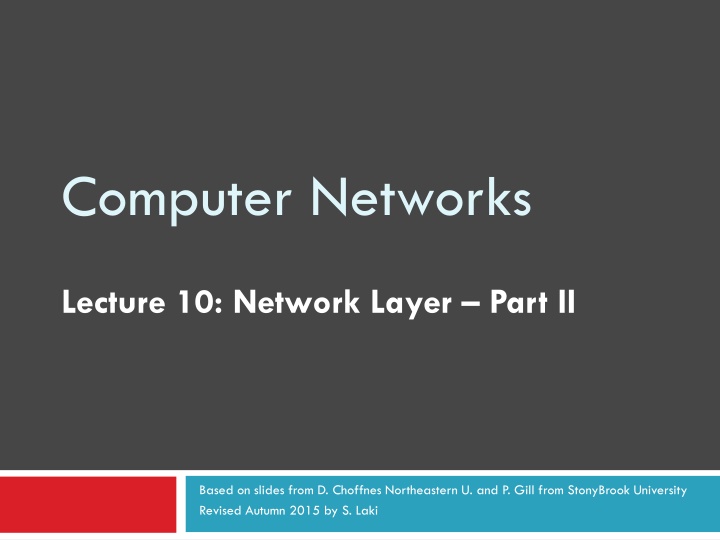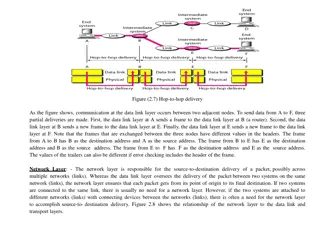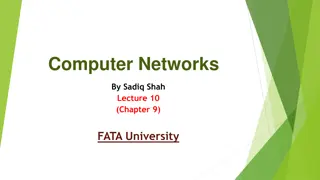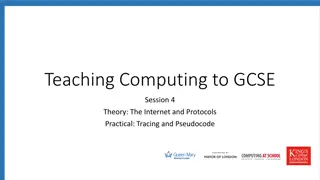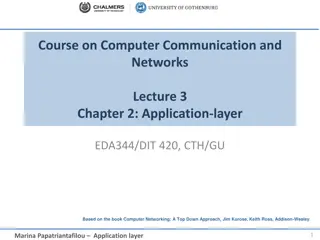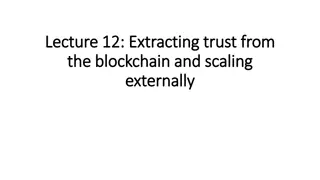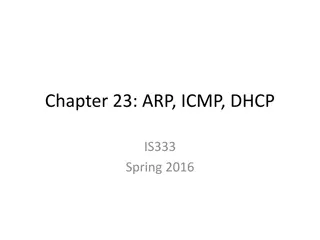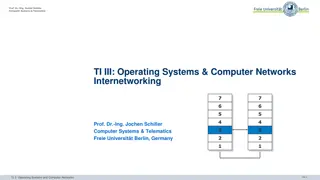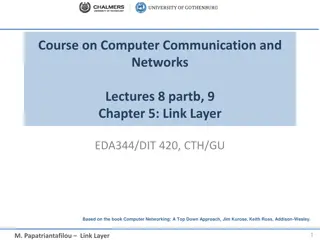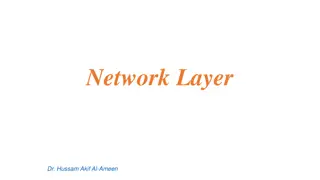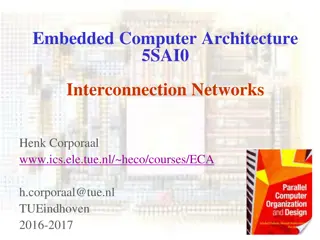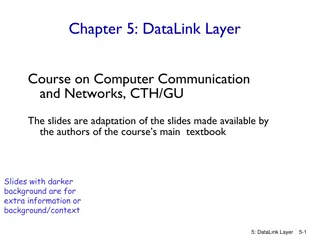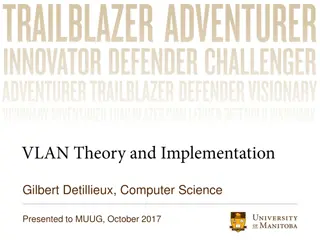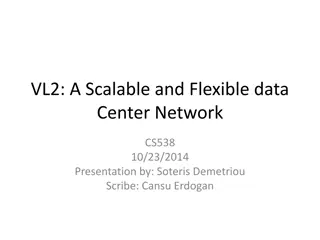Computer Networks: Network Layer Part II Overview
This presentation delves into the intricacies of the network layer in computer networks, focusing on routing packets efficiently through multiple hops. It covers topics such as address representation, packet routing, scalability, and convergence. Explore the functions of the network layer, intra-domain routing protocols like RIP and OSPF, distance vector routing, and algorithms for efficient pathfinding. Dive into the details of distance vector routing algorithms, initialization processes, and iterative steps to optimize routing decisions.
Download Presentation

Please find below an Image/Link to download the presentation.
The content on the website is provided AS IS for your information and personal use only. It may not be sold, licensed, or shared on other websites without obtaining consent from the author.If you encounter any issues during the download, it is possible that the publisher has removed the file from their server.
You are allowed to download the files provided on this website for personal or commercial use, subject to the condition that they are used lawfully. All files are the property of their respective owners.
The content on the website is provided AS IS for your information and personal use only. It may not be sold, licensed, or shared on other websites without obtaining consent from the author.
E N D
Presentation Transcript
Computer Networks Lecture 10: Network Layer Part II Based on slides from D. Choffnes Northeastern U. and P. Gill from StonyBrook University Revised Autumn 2015 by S. Laki
Network Layer 2 Function: Route packets end-to-end on a network, through multiple hops Application Presentation Session Transport Network Data Link Physical Key challenge: How to represent addresses How to route packets Scalability Convergence
Intra-domain Routing Protocols 3 Distance vector Routing Information Protocol (RIP), based on Bellman-Ford Routers periodically exchange reachability information with neighbors Link state Open Shortest Path First (OSPF), based on Dijkstra Each network periodically floods immediate reachability information to all other routers Per router local computation to determine full routes 3
Outline 4 Distance Vector Routing RIP Link State Routing OSPF IS-IS
Distance Vector Routing 5 What is a distance vector? Current best known cost to reach a destination Idea: exchange vectors among neighbors to learn about lowest cost paths No entry for C Destination Cost Initially, only has info for immediate neighbors A 7 DV Table at Node C B 1 D 2 Other destinations cost = E 5 Eventually, vector is filled F 1 Routing Information Protocol (RIP)
Distance Vector Routing Algorithm 6 Wait for change in local link cost or message from neighbor 1. Recompute distance table 2. If least cost path to any destination has changed, notify neighbors 3.
Distance Vector Initialization 7 Node B Node A 3 B D Dest. Cost Next Dest. Cost Next 2 1 B 2 B A 2 A 1 C 7 C C 1 C A C 7 D D 3 D 1. 2. 3. 4. 5. 6. Initialization: for all neighbors V do ifV adjacent to A D(A, V) = c(A,V); else D(A, V) = ; Node D Node C Dest. Cost Next Dest. Cost Next A 7 A A B 1 B B 3 B D 1 D C 1 C
Distance Vector: 1st Iteration 8 Node B Node A 3 B D Dest. Cost Next Dest. Cost Next 2 1 B 2 3 B A 2 A 1 C B C 7 C 1 C A C 7 D D 3 2 D C 8 5 C B 7. 12. 13. 14. 15. 16. 17. 18. 19. 20. loop: else if (update D(V, Y) received from V) for all destinations Y do if (destination Y through V) D(A,Y) = D(A,V) + D(V, Y); else D(A, Y) = min(D(A, Y), D(A, V) + D(V, Y)); if (there is a new min. for dest. Y) send D(A, Y) to all neighbors forever D(A,C) = min(D(A,C), D(A,B)+D(B,C)) = min(7, 2 + 1) = 3 D(A,D) = min(D(A,D), D(A,B)+D(B,D)) Node D Node C D(A,D) = min(D(A,D), D(A,C)+D(C,D)) = min( , 7 + 1) = 8 = min(8, 2 + 3) = 5 Dest. Cost Next Dest. Cost Next 7 3 A B 4 B A A B 1 B B 3 B D 1 D C 1 C
Distance Vector: End of 3rd Iteration 9 Node B Node A 3 B D Dest. Cost Next Dest. Cost Next 2 1 B 2 B A 2 A 1 C 3 B C 1 C A C 7 D B D 2 C 4 7. 12. 13. 14. 15. 16. 17. 18. 19. 20. loop: Nothing changes, algorithm terminates Until something changes else if (update D(V, Y) received from V) for all destinations Y do if (destination Y through V) D(A,Y) = D(A,V) + D(V, Y); else D(A, Y) = min(D(A, Y), D(A, V) + D(V, Y)); if (there is a new min. for dest. Y) send D(A, Y) to all neighbors forever Node D Node C Dest. Cost Next Dest. Cost Next A 3 B A C 4 B 1 B B 2 C D 1 D C 1 C
7. 8. 9. 10. 11. 12. 13. 14. 15. 16. 17. 18. 19. 20. loop: wait (link cost update or update message) if (c(A,V) changes by d) for all destinations Y through Vdo D(A,Y) = D(A,Y) + d else if (update D(V, Y) received from V) for all destinations Y do if (destination Y through V) D(A,Y) = D(A,V) + D(V, Y); else D(A, Y) = min(D(A, Y), D(A, V) + D(V, Y)); if (there is a new minimum for destination Y) send D(A, Y) to all neighbors forever Algorithm Starts B 10 4 1 1 A C 50 Link Cost Changes, Good news travels fast Algorithm Terminates D C N D C N D C N D C N Node B A 1 A A 4 A A 1 A A 1 A C 1 B C 1 B C 1 B C 1 B D C N D C N D C N D C N Node C A 5 B A 5 B A 2 B A 2 B B 1 B B 1 B B 1 B B 1 B Time
Count to Infinity Problem 11 Node B knows D(C, A) = 5 However, B does not know the path is C B A Thus, D(B,A) = 6 ! Bad news travels slowly B 4 60 1 A C 50 D C N D C N D C N D C N Node B A 6 C A 4 A A 6 C A 8 C C 1 B C 1 B C 1 B C 1 B D C N D C N D C N D C N Node C A 5 B A 5 B A 7 B A 7 B B 1 B B 1 B B 1 B B 1 B Time
Poisoned Reverse 12 If C routes through B to get to A B C tells B that D(C, A) = Thus, B won t route to A via C 4 60 1 A C 50 D C N D C N D C N D C N Node B A 60 A A 4 A A 60 A A 51 C C 1 B C 1 B C 1 B C 1 B D C N D C N D C N D C N Node C A 5 B A 5 B A 50 A A 50 A B 1 B B 1 B B 1 B B 1 B Time
Outline 13 Distance Vector Routing RIP Link State Routing OSPF IS-IS
Link State Routing 14 Each node knows its connectivity and cost to direct neighbors Each node tells every other node this information Each node learns complete network topology Use Dijkstra to compute shortest paths
Flooding Details 15 Each node periodically generates Link State Packet ID of node generating the LSP List of direct neighbors and costs Sequence number (64-bit, assumed to never wrap) Time to live Flood is reliable (ack + retransmission) Sequence number versions each LSP Receivers flood LSPs to their own neighbors Except whoever originated the LSP LSPs also generated when link states change
OSPF vs. IS-IS 16 Two different implementations of link-state routing OSPF IS-IS Favored by companies, datacenters More optional features Favored by ISPs Less chatty Less network overhead Supports more devices Not tied to IP Built on top of IPv4 LSAs are sent via IPv4 OSPFv3 needed for IPv6 Works with IPv4 or IPv6
Different Organizational Structure 17 OSPF IS-IS Organized around overlapping areas Organized as a 2-level hierarchy Area 0 is the core network Level 2 is the backbone Level 1-2 Level 1 Level 2 Area 2 Area 1 Area 0 Area 4 Area 3
Network Layer, Control Plane 18 Function: Set up routes between networks Data Plane Key challenges: Implementing provider policies Creating stable paths Application Presentation Session Transport Network Data Link Physical Control Plane RIP OSPF BGP
Outline 19 BGP Basics Stable Paths Problem BGP in the Real World Debugging BGP Path Problems
ASs, Revisited 20 AS-1 AS-3 Interior Routers AS-2 BGP Routers
AS Numbers 21 Each AS identified by an ASN number 16-bit values (latest protocol supports 32-bit ones) 64512 65535 are reserved Currently, there are ~ 40000 ASNs AT&T: 5074, 6341, 7018, Sprint: 1239, 1240, 6211, 6242, ELTE: 2012 Google 15169, 36561 (formerly YT), + others Facebook 32934 North America ASs ftp://ftp.arin.net/info/asn.txt
Inter-Domain Routing 22 Global connectivity is at stake! Thus, all ASs must use the same protocol Contrast with intra-domain routing What are the requirements? Scalability Flexibility in choosing routes Cost Routing around failures Question: link state or distance vector? Trick question: BGP is a path vector protocol
BGP 23 Border Gateway Protocol De facto inter-domain protocol of the Internet Policy based routing protocol Uses a Bellman-Ford path vector protocol Relatively simple protocol, but Complex, manual configuration Entire world sees advertisements Errors can screw up traffic globally Policies driven by economics How much $$$ does it cost to route along a given path? Not by performance (e.g. shortest paths)
BGP Relationships 24 Provider Peer 2 has no incentive to route 1 3 $ Peers do not pay each other Peer 3 Customer Peer 1 Customer Provider Peer 2 Customer pays provider Customer
Tier-1 ISP Peering 25 Inteliquent Centurylink Verizon Business AT&T So you want to be a tier 1 network? All you have to do is get all the other tier 1s to peer with you! (not that easy ) Sprint Level 3 XO Communications
Peering Wars 27 Peer Don t Peer Reduce upstream costs You would rather have customers Improve end-to-end performance Peering struggles in the ISP world are extremely contentious agreements are usually confidential Peers are often competitors May be the only way to connect to parts of the Internet Example: If you are a customer of my peer why should I peer with you? You should pay me too! Incentive to keep relationships private! Peering agreements require periodic renegotiation
Two Types of BGP Neighbors 28 Exterior routers also speak IGP IGP eBGP eBGP iBGP iBGP
Full iBGP Meshes 29 Question: why do we need iBGP? OSPF does not include BGP policy info Prevents routing loops within the AS eBGP iBGP iBGP updates do not trigger announcements
Path Vector Protocol 30 AS-path: sequence of ASs a route traverses Like distance vector, plus additional information Used for loop detection and to apply policy AS 4 E.g., pick cheapest/shortest path 120.10.0.0/16 Routing done based on longest prefix match AS 3 130.10.0.0/16 AS 5 AS 2 110.10.0.0/16 120.10.0.0/16: AS 2 AS 3 AS 4 130.10.0.0/16: AS 2 AS 3 110.10.0.0/16: AS 2 AS 5 AS 1
Path-Vector Routing Extension of distance-vector routing Support flexible routing policies Avoid count-to-infinity problem Key idea: advertise the entire path Distance vector: send distance metric per dest d Path vector: send the entire path for each dest d d: path (2,1) d: path (1) 3 1 2 data traffic data traffic d 31
Flexible Policies Each node can apply local policies Path selection: Which path to use? Path export: Which paths to advertise? Examples Node 2 may prefer the path 2, 3, 1 over 2, 1 Node 1 may not let node 3 hear the path 1, 2 2 3 1 32
BGP Operations (Simplified) 33 Establish session on TCP port 179 AS-1 Exchange active routes AS-2 Exchange incremental updates
Four Types of BGP Messages 34 Open: Establish a peering session. Keep Alive: Handshake at regular intervals. Notification: Shuts down a peering session. Update: Announce new routes or withdraw previously announced routes. announcement = IP prefix + attributes values
BGP Attributes 35 Attributes used to select best path LocalPref Local preference policy to choose most preferred route Overrides default fewest AS behavior Multi-exit Discriminator (MED) Specifies path for external traffic destined for an internal network Chooses peering point for your network Import Rules What route advertisements do I accept? Export Rules Which routes do I forward to whom?
Shortest AS Path != Shortest Path 36 9 hops 2 ASs 4 hops 4 ASs Source Destination
Hot Potato Routing 37 Pick the next hop with the shortest IGP route Source Destination
Importing Routes 38 ISP Routes From Provider From Peer From Peer From Customer
Exporting Routes 39 $$$ generating routes Customer and ISP routes only To Provider To Peer To Peer To Customer Customers get all routes
Modeling BGP 40 AS relationships Customer/provider Peer Sibling, IXP Gao-Rexford model AS prefers to use customer path, then peer, then provider Follow the money! Valley-free routing Hierarchical view of routing (incorrect but frequently used) P-P P-P P-C C-P P-C P-P
AS Relationships: Its Complicated 41 GR Model is strictly hierarchical Each AS pair has exactly one relationship Each relationship is the same for all prefixes In practice it s much more complicated Rise of widespread peering Regional, per-prefix peerings Tier-1 s being shoved out by hypergiants IXPs dominating traffic volume Modeling is very hard, very prone to error Huge potential impact for understanding Internet behavior
Other BGP Attributes 42 AS_SET Instead of a single AS appearing at a slot, it s a set of Ases Communities Arbitrary number that is used by neighbors for routing decisions Export this route only in Europe Do not export to your peers Usually stripped after first interdomain hop Why? Prepending Lengthening the route by adding multiple instances of ASN Why?
Transport Layer 43 Function: Demultiplexing of data streams Application Presentation Session Transport Network Data Link Physical Optional functions: Creating long lived connections Reliable, in-order packet delivery Error detection Flow and congestion control Key challenges: Detecting and responding to congestion Balancing fairness against high utilization
Outline 44 UDP TCP Congestion Control Evolution of TCP Problems with TCP
The Case for Multiplexing 45 Datagram network No circuits No connections Clients run many applications at the same time Who to deliver packets to? Transport Network Data Link Physical IP header protocol field 8 bits = 256 concurrent streams Insert Transport Layer to handle demultiplexing Packet
Demultiplexing Traffic Server applications communicate with multiple clients 46 Host 1 Host 2 Host 3 Unique port for each application Applications share the same network Application Transport P1 P2 P3 P4 P5 P6 P7 Network Endpoints identified by <src_ip, src_port, dest_ip, dest_port>
Layering, Revisited 47 Layers communicate peer- to-peer Host 1 Host 2 Router Application Transport Network Data Link Physical Application Transport Network Data Link Physical Network Data Link Physical Lowest level end-to-end protocol Transport header only read by source and destination Routers view transport header as payload
User Datagram Protocol (UDP) 48 0 16 31 Destination Port Checksum Source Port Payload Length Simple, connectionless datagram C sockets: SOCK_DGRAM Port numbers enable demultiplexing 16 bits = 65535 possible ports Port 0 is invalid Checksum for error detection Detects (some) corrupt packets Does not detect dropped, duplicated, or reordered packets
Uses for UDP 49 Invented after TCP Why? Not all applications can tolerate TCP Custom protocols can be built on top of UDP Reliability? Strict ordering? Flow control? Congestion control? Examples RTMP, real-time media streaming (e.g. voice, video) Facebook datacenter protocol
Outline 50 UDP already discussed TCP Congestion Control Evolution of TCP Problems with TCP
